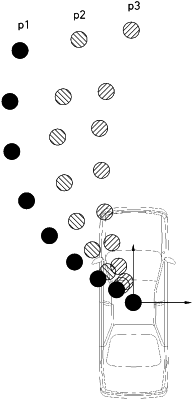| CPC B60W 60/0011 (2020.02) [B60W 10/20 (2013.01); B60W 40/105 (2013.01); B60W 60/0015 (2020.02); G06N 3/049 (2013.01); G06N 3/08 (2013.01); B60W 2520/14 (2013.01); B60W 2520/16 (2013.01); B60W 2520/18 (2013.01); B60W 2540/18 (2013.01); B60W 2556/50 (2020.02); B60W 2556/60 (2020.02)] | 17 Claims |

|
1. A method of generating and controlling a driving path in an autonomous vehicle, the method comprising:
acquiring sensing data for an outside of the autonomous vehicle through at least one sensing module coupled to the autonomous vehicle;
generating a plurality of driving paths corresponding to the driving intention information by using the sensing data, driving intention information, and target speed information as input data for a first artificial neural network;
evaluating a degree of risk of each of the plurality of driving paths from object information recognized on the basis of the sensing information;
determining steering angle information for the autonomous vehicle by using the driving path having a lowest degree of risk and the target speed information as input data for a second artificial neural network; and
controlling a steering angle of the autonomous vehicle on the basis of the determined steering angle information,
wherein the generating of the plurality of driving paths corresponding to the driving intention information includes:
extracting a feature vector using the sensing data as input data of a convolution neural network (CNN)-based feature extraction algorithm; and
while using the feature vector, the target speed information, the driving intention information, and a noise vector as input data of a recurrent neural network (RNN)-based path generation algorithm, repeatedly varying the noise vector to generate the plurality of driving paths.
|